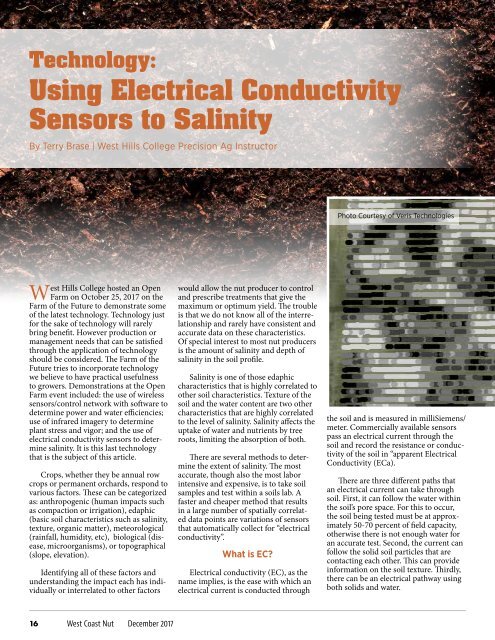WCN_Dec17WEB
Create successful ePaper yourself
Turn your PDF publications into a flip-book with our unique Google optimized e-Paper software.
Technology:<br />
Using Electrical Conductivity<br />
Sensors to Salinity<br />
By Terry Brase | West Hills College Precision Ag Instructor<br />
Photo Courtesy of Veris Technologies<br />
West Hills College hosted an Open<br />
Farm on October 25, 2017 on the<br />
Farm of the Future to demonstrate some<br />
of the latest technology. Technology just<br />
for the sake of technology will rarely<br />
bring benefit. However production or<br />
management needs that can be satisfied<br />
through the application of technology<br />
should be considered. The Farm of the<br />
Future tries to incorporate technology<br />
we believe to have practical usefulness<br />
to growers. Demonstrations at the Open<br />
Farm event included: the use of wireless<br />
sensors/control network with software to<br />
determine power and water efficiencies;<br />
use of infrared imagery to determine<br />
plant stress and vigor; and the use of<br />
electrical conductivity sensors to determine<br />
salinity. It is this last technology<br />
that is the subject of this article.<br />
Crops, whether they be annual row<br />
crops or permanent orchards, respond to<br />
various factors. These can be categorized<br />
as: anthropogenic (human impacts such<br />
as compaction or irrigation), edaphic<br />
(basic soil characteristics such as salinity,<br />
texture, organic matter), meteorological<br />
(rainfall, humidity, etc), biological (disease,<br />
microorganisms), or topographical<br />
(slope, elevation).<br />
Identifying all of these factors and<br />
understanding the impact each has individually<br />
or interrelated to other factors<br />
would allow the nut producer to control<br />
and prescribe treatments that give the<br />
maximum or optimum yield. The trouble<br />
is that we do not know all of the interrelationship<br />
and rarely have consistent and<br />
accurate data on these characteristics.<br />
Of special interest to most nut producers<br />
is the amount of salinity and depth of<br />
salinity in the soil profile.<br />
Salinity is one of those edaphic<br />
characteristics that is highly correlated to<br />
other soil characteristics. Texture of the<br />
soil and the water content are two other<br />
characteristics that are highly correlated<br />
to the level of salinity. Salinity affects the<br />
uptake of water and nutrients by tree<br />
roots, limiting the absorption of both.<br />
There are several methods to determine<br />
the extent of salinity. The most<br />
accurate, though also the most labor<br />
intensive and expensive, is to take soil<br />
samples and test within a soils lab. A<br />
faster and cheaper method that results<br />
in a large number of spatially correlated<br />
data points are variations of sensors<br />
that automatically collect for “electrical<br />
conductivity”.<br />
What is EC?<br />
Electrical conductivity (EC), as the<br />
name implies, is the ease with which an<br />
electrical current is conducted through<br />
the soil and is measured in milliSiemens/<br />
meter. Commercially available sensors<br />
pass an electrical current through the<br />
soil and record the resistance or conductivity<br />
of the soil in “apparent Electrical<br />
Conductivity (ECa).<br />
There are three different paths that<br />
an electrical current can take through<br />
soil. First, it can follow the water within<br />
the soil’s pore space. For this to occur,<br />
the soil being tested must be at approximately<br />
50-70 percent of field capacity,<br />
otherwise there is not enough water for<br />
an accurate test. Second, the current can<br />
follow the solid soil particles that are<br />
contacting each other. This can provide<br />
information on the soil texture. Thirdly,<br />
there can be an electrical pathway using<br />
both solids and water.<br />
16 West Coast Nut December 2017


















